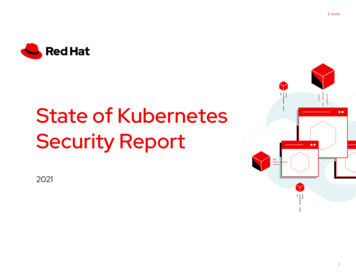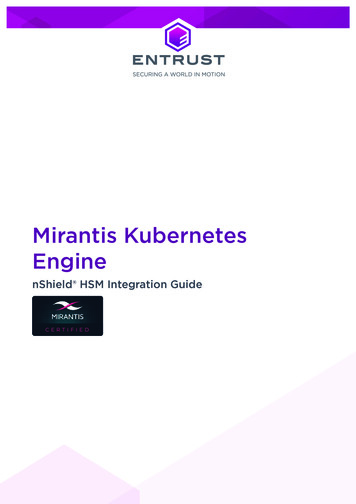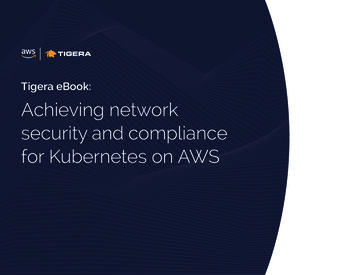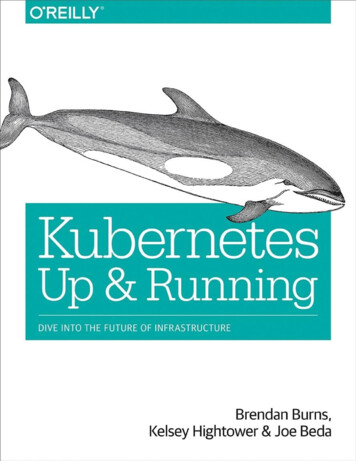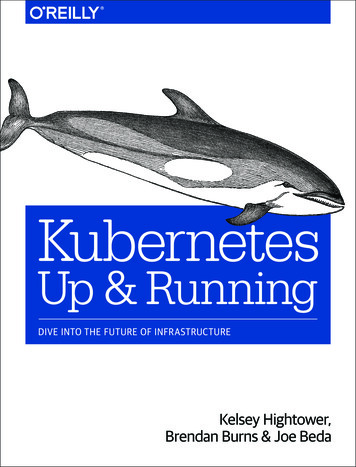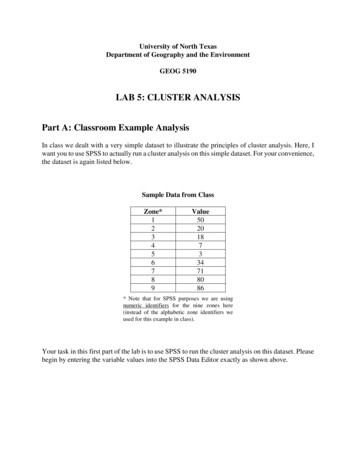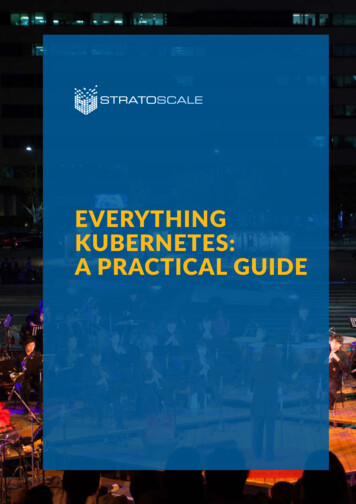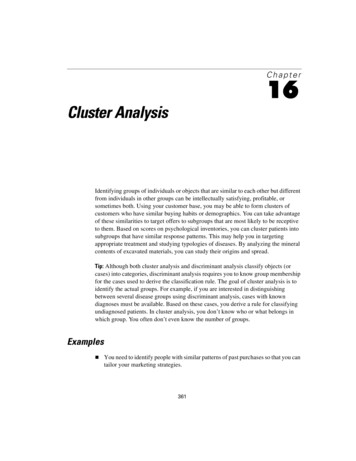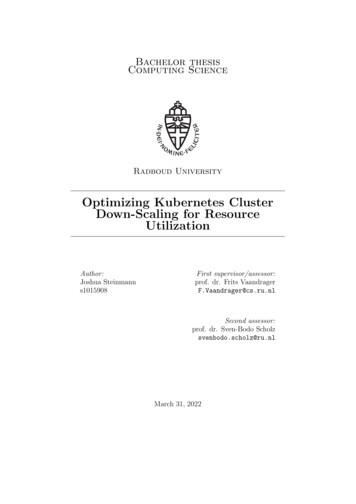
Transcription
Bachelor thesisComputing ScienceRadboud UniversityOptimizing Kubernetes ClusterDown-Scaling for ResourceUtilizationAuthor:Joshua Steinmanns1015908First supervisor/assessor:prof. dr. Frits VaandragerF.Vaandrager@cs.ru.nlSecond assessor:prof. dr. Sven-Bodo Scholzsvenbodo.scholz@ru.nlMarch 31, 2022
AbstractKubernetes is a widely adopted technology today. One of its main advantages is automatic deployment and even cluster scaling. The default procedure for scaling down a cluster has some shortcomings and does not allow forpredictable behavior while decreasing the cluster size as much as possible.While the default implementation works with per node resource utilizationthresholds to determine which nodes can be removed from the cluster, theprocedure proposed in this thesis makes use of thresholds set for the wholecluster. These thresholds describe the maximal resource utilization thatshould be present in the cluster after a scale-down. The notion of usableresources is introduced to express the ratio of free resources in a clusterstate more precisely. The proposed down-scaler works towards decreasingthe cluster size as much as possible without violating any thresholds. Whilea similar behavior can be reproduced using the default implementation andoverprovisioning, it does not work in all scenarios and involves complex additional deployments.
Contents1 Introduction32 Kubernetes Concepts2.1 Microservices . . . . . . . . . . .2.2 Container Orchestration . . . . .2.3 Kubernetes Concepts . . . . . . .2.3.1 Pod . . . . . . . . . . . .2.3.2 Replica Set . . . . . . . .2.3.3 Pod Disruption Budget .2.4 Resources and labels . . . . . . .2.4.1 Requests and limits . . .2.4.2 Units . . . . . . . . . . .2.4.3 Node Labels . . . . . . . .2.5 Scheduler . . . . . . . . . . . . .2.6 Autoscaling . . . . . . . . . . . .2.6.1 Horizontal Pod Autoscaler2.6.2 Cluster Autoscaler (CA) .4445555666777883 Shortcomings of the default scale-down procedure104 An alternative down-scaling procedure4.1 The concept . . . . . . . . . . . . . . . .4.2 Utility functions . . . . . . . . . . . . .4.2.1 Cluster capacity . . . . . . . . .4.2.2 Node and cluster requests . . . .4.2.3 Daemon set requests . . . . . . .4.3 Usable resources and usable capacity . .4.4 Candidate check . . . . . . . . . . . . .4.5 Evaluating candidates . . . . . . . . . .4.6 The complete procedure . . . . . . . . .4.7 Functions to be implemented . . . . . .4.7.1 Bin-packing . . . . . . . . . . . .4.7.2 Removing Node from Cluster . .121212121314151718192020201.
4.8The order of checks . . . . . . . . . . . . . . . . . . . . . . . .5 Discussion5.1 Differences to the default implementation . .5.1.1 Thresholds . . . . . . . . . . . . . . .5.1.2 General approach . . . . . . . . . . . .5.2 Advantages of the proposed down-scaler . . .5.3 Advantages of the default down-scaler . . . .5.4 Recreating the proposed behavior . . . . . . .5.4.1 Overprovisioning using the default CA5.4.2 Recreating proposed behavior . . . . .5.4.3 Use in practice . . . . . . . . . . . . .6 Conclusions and Future Work2.202222222223232323242425
Chapter 1IntroductionKubernetes and containerization are widely adopted technologies. Kubernetes is a platform for managing and distributing containerized workloadsacross multiple nodes. 31% of backend developers have used Kubernetesin the past 12 months (based on data from December of 2021 [11]). Only11% have never heard of it. The adoption in the industry is accompanied by research efforts dedicated to improving the technology. One of thebiggest advantages of using Kubernetes is the automatic scaling of application deployments or even the whole cluster to meet the computational powerrequired at any moment.Related WorkQiang Wu et al. [13] present a cluster auto-scaler that determines the optimal cluster size based on the notion of Quality of Service (QoS). The QoSis defined by the response time of user requests. Given a maximal desiredresponse time, the presented auto-scaler scales the cluster to not exceedthe desired response time, while keeping the cluster as small as possible.The auto-scaler consists of four modules. The first one monitors the clusterstate while the second one decides the QoS threshold. Based on that thethird module computes the optimal cluster size and the fourth module thenadjusts the cluster size to match the optimal size.Related work by László Toka et al. [12] presents an auto-scaler that usesmachine learning to predict the computational load in the near future. Multiple forecast methods compete, and based on the current request dynamics,the best method is given the lead. Based on the result, deployments are horizontally scaled (explained in section 2.6.1) to meet the predicted load. Theinfluence on the cluster size is indirect as scaling deployments might resultin cluster up or down-scaling, but the cluster size is not adjusted directly.3
Chapter 2Kubernetes Concepts2.1MicroservicesThe concept of microservices is a software architecture design pattern.The naive way of designing an application is to build all required featuresinto one monolithic service. Designing an application using the microservices pattern enforces the separation of feature groups into distinct services.These services mostly use network communication to provide the desiredfunctionality. More information on microservices can be found in the book”Building Microservices” [9].The relevant aspect of microservices for this thesis is their horizontal scalability. It describes the process of increasing the processing capability of aservice by increasing the number of concurrent instances. The typical wayto deploy microservices is to use containerization. By using containers thedependencies and service binaries are bundled in one image that can bedeployed using a container runtime like docker or containerd.2.2Container OrchestrationDeploying an application as a collection of microservices implies that a multitude of containers needs to be deployed and managed. Container orchestrators, like the most prominent one Kubernetes, take care of this task.Google describes it as follows: ”Google Cloud Platform provides a homogenous set of raw resources via virtual machines (VMs) to Kubernetes, andin turn, Kubernetes schedules containers to use those resources. This decoupling simplifies application development since users only ask for abstractresources like cores and memory, and it also simplifies data center operations.” [8] Google continues to explain that Kubernetes also takes careof (inter-container) networking and persistent storage. For this thesis, themost relevant feature of Kubernetes is automatic scaling. The importantterminology and the different concepts of autoscaling will be described in4
the following paragraphs.2.3Kubernetes ConceptsThe following sections in this chapter are largely based on and frequentlycite the official Kubernetes documentation [5].2.3.1PodPods are the smallest deployable units of computing that you can create andmanage in Kubernetes. A pod is a group of one or more containers, withshared storage and network resources, and a specification for how to runthe containers. A pod’s contents are always co-located and co-scheduled,and run in a shared context. A pod models an application-specific ”logicalhost”: it contains one or more application containers which are relativelytightly coupled. In non-cloud contexts, applications executed on the samephysical or virtual machine are analogous to cloud applications executed onthe same logical host. While pods provide more functionality in theory theyare mostly used as a wrapper around a single container.2.3.2Replica SetA replica set’s purpose is to maintain a stable set of replica pods running atany given time. As such, it is often used to guarantee the availability of aspecified number of identical pods. To do so, a replica set has a replicationcount and a template for the pod. Pods can be created based on the templateor removed to match the replication count. Each pod can only be part of onereplica set. Pods running on a node that fails get the state ”Unknown” andare not counted as running replications. As a result, the replica set createsnew pods on healthy nodes to reach the desired count of replications.2.3.3Pod Disruption BudgetA pod disruption budget specifies the desired minimum number of runninginstances of a pod in the ready state. This feature is useful for highlyavailable applications as the pure amount of pods running the service isnot enough to ensure availability. Pods in the creation or startup stage arecounted by a replica set, but cannot provide their service yet. Pod disruptionbudgets ensure that the number of ready replications does not fall below thespecified threshold by voluntary disruptions. A voluntary disruption is everyoperation on the cluster that is performed on purpose and causes a pod to berescheduled. Host node failure obviously is not a voluntary disruption. Poddisruption budgets can be defined in terms of relative and absolute valuesfor the minimum of available or the maximum of unavailable pods.5
2.4Resources and labelsThe following sections explain the notion and units of resources as well asthe concept of node labels.2.4.1Requests and limitsFor each container requests, as well as limits can be specified for resourcetypes. The most common resource types are CPU and RAM. For schedulingonly the resource requests and limits of pods are relevant. Those are specified as the sum of requests and limits of all containers in the pod for eachindividual resource type. (Remember that pods are the smallest deployableunit of Kubernetes.) A request ensures that the particular resource is available for use by the pod. Hence the scheduler will not schedule another podon a node the resources of which are already requested by running podseven though the current resource utilization might be low. The term ”request” is misleading in the way that the request is nothing that is grantedor rejected, but more like a constraint for scheduling. If a request is set,the resources are always reserved if they are available and if the resourcesare not available the pod cannot be scheduled. A limit makes sure that thepod does not use more resources than the specified amount. If a containerexceeds its memory limit, it might be terminated. If it is restartable, itwill be restarted, as with any other type of runtime failure. If a containerexceeds its memory request, its pod will likely be evicted whenever the noderuns out of memory. A container might or might not be allowed to exceedits CPU limit for extended periods of time. However, it will not be killed forexcessive CPU usage. Setting resource requests and limits is a best practiceto ensure that each pod has sufficient resources available, but also does notuse more resources than it should. Misconfiguration or bugs might lead toexcessive resource usage by a single pod otherwise [6]. This thesis assumesthat all pods have resource requests specified for CPU and RAM.2.4.2UnitsLimits and requests for CPU resources are measured in cpu units. Onecpu, in Kubernetes, is equivalent to 1 vCPU/Core for cloud providers and 1hyperthread on bare-metal Intel processors. Fractional requests like 0.5 areallowed, but the unit ”millicpu” (m) is preferred as requests smaller than1m are not allowed. A CPU request of 0.2 equals a request of 200m. Limitsand requests for memory are measured in bytes. You can express memoryas a plain integer or as a fixed-point number using one of these suffixes: E,P, T, G, M, K. You can also use the power-of-two equivalents: Ei, Pi, Ti,Gi, Mi, Ki.6
2.4.3Node LabelsIn Kubernetes, every object can be labeled. In the context of this thesisonly node labels are relevant. A label is defined in terms of a key/value pairand can be used to express relevant differences in hardware for example. Acluster containing different types of nodes might have labels to express thedifferences in accelerators or drive types. Node type A might have especiallyfast SSDs, while node type B has a focus on the size of RAM. The accordinglabels might look like this:Node type A: { disk-type: nvme, memory-size: medium }Node type B: { disk-type: sata-ssd, memory-size: large }To ensure that pods housing workloads that benefit from special hardwarerun on the appropriate nodes there are required and preferred node (anti)affinities as well as node selectors. A node selector requires the schedulerto place the pod on a node that has a certain label. Required node (anti)affinity is essentially the same thing, while preferred node (anti-)affinityexpresses a preference only. It does not prevent the pod to be scheduled ona node having or not having a certain label. Preferred node (anti-)affinitiescan also have a weight to balance multiple of the kind. A pod running anin-memory database might have a required node affinity for { memory-size:large } to not block all RAM on a node of a different kind. On the otherhand, a pod running an application that needs a fast scratch disk mighthave a preferred node affinity for { disk-type: nvme } as the application canalso run with slower disks without harming the cluster. The faster disks arepreferred however to allow the application to run faster.2.5SchedulerA scheduler watches for newly created pods that have no node assigned. Forevery pod that the scheduler discovers, the scheduler becomes responsiblefor finding the best node for that pod to run on. The default kube-schedulerselects a suitable node in two steps. The first step, the filtering step findsthe set of nodes where it’s feasible to schedule the pod. In the second step,the scoring step, the scheduler ranks the remaining nodes to choose the mostsuitable pod placement.2.6AutoscalingAutoscaling is the automatic process of increasing or decreasing the computational capacity of a cluster or an application deployment.7
2.6.1Horizontal Pod AutoscalerThe horizontal pod auto-scaler adjusts the pod replication count of a replicaset based on observed resource utilization. To allow scaling based on thedesired resource metric a desired per pod utilization value needs to be set.The utilization value can be absolute or relative. The desired replicationcount is then computed using the following formula.desiredReplicas dcurrentReplicas (currentM etricV alue/desiredM etricV alue)eThe current metric value is the average of all running pods. Only pods inthe ready state are used for the computation.2.6.2Cluster Autoscaler (CA)The CA’s task is to adjust the size of the cluster in order to meet the current resource requirements. The assumption is that the cluster runs on aset of node groups. Within a node group, all nodes have identical hardwarespecifications.In case a new pod cannot be scheduled because it for example requests moreCPU or RAM than is available on any of the current cluster nodes, the scaleup routine is triggered. The routine checks if adding a node to any of thenode groups allows the previously unschedulable pod to be scheduled. Ifone node group suits the needs a node is added to that group. If multiplenode groups meet the requirements one is selected by instance price or moresophisticated criteria.In case a current cluster node’s CPU and RAM is utilized below a certainthreshold the scale-down routine is triggered. The CA scans the cluster forunderutilized nodes every 10 seconds (this interval can be changed). A nodeis considered underutilized if the sum of CPU and RAM requests of all podsrunning on the node is less than a certain percentage of the node’s availableresources. The default utilization threshold is 50%, but it can be adjusted.For every underutilized node, the CA checks whether all pods running onthe node can be rescheduled on other nodes. The check uses the first fitdecreasing bin-packing approximation algorithm to check whether the podscould be scheduled on other nodes. Pods, that do not need to be rescheduled in case the node is removed, are excluded from the check. The CAalso checks whether the node has a scale-down disabled annotation whichprevents the node from being removed. If the node’s utilization stays belowthe threshold for 10 minutes (this time can be configured) and all its podscan be rescheduled the node is removed from the cluster. The procedure described is the default, but there are quite some cases that stop the removalof a node. The most relevant include pods that are part of the control planeof Kubernetes and do not have a pod disruption budget set or generallypods that have a pod disruption budget that currently does not allow the8
pod to be terminated. There might also be other factors like pods requiringnode labels that currently cannot be satisfied by any other node.More information on Kubernetes can be found in the official documentation [5].9
Chapter 3Shortcomings of the defaultscale-down procedureThe following sections describe the shortcomings of the default CA’s scaledown procedure and their implications for resource utilization in Kubernetesclusters.Due to the fact that only nodes which are utilized below a specified threshold are considered forremoval, the default scale-down procedure potentially misses many opportunities for scaling downthe cluster. This fact can be illustrated using Figure 3.1. In the example, each node has 4 CPU coresand 8 gigabytes of RAM. Node 4 has a ”green” labeland pod F has a required node label affinity for the”green” label. This fact is indicated by the greencolor. The default scale-down procedure only considers node 4 to be removed as all other nodes havea resource utilized more than 50%. When trying toschedule pod F on a different node the procedureends as no other node has the ”green” label. If theutilization threshold is increased to 80%, then node1 and node 2 are considered for removal. Node 1can in fact be removed as pod A can be rescheduled on node 4. The same holds for node 2 as podB can be rescheduled on node 3 and pod C can Figure 3.1: Clusterbe rescheduled on node 4. There is no metric that State 1determines which of the nodes should be removedfirst, but assuming that the pods are rescheduled according to the defaultfirst fit decreasing bin packing algorithm, the resulting cluster state wouldbe like pictured in 3.2. When optimizing for resource utilization cluster state2 seems optimal as the cluster size is reduced as much as possible. From10
Figure 3.2: Cluster State 2an operational perspective, the cluster state might not be desirable as itleaves no room for scaling any of the pods up horizontally except for podC. In the case that any other pod would need to be replicated to deal witha peak load, a new node would have to be added to the cluster. Addinga node to the cluster can take multiple minutes, so the advantage of quickhorizontal scaling would be lost. Hence picking a low utilization thresholdpotentially misses out on opportunities for scaling down, while picking ahigher utilization threshold might remove too many nodes.11
Chapter 4An alternative down-scalingprocedureThe following sections present a conceptually different down-scaling procedure that allows the CA to detect more opportunities for scaling the clusterdown while keeping enough free resources to allow for quick horizontal deployment scaling.4.1The conceptThe new down-scaler mainly relies on a total cluster utilization threshold.This threshold is defined in terms of both a CPU utilization and a RAMutilization percentage. The proposed down-scaler aims to remove the mostexpensive node possible from the cluster while guaranteeing that no resourceis utilized above the set threshold. To give even stronger guarantees thenotion of usable free resources is introduced to ensure that any resourceunit considered free by the utilization percentage is actually available tobe used by a pod. Examples and detailed explanations are given in thefollowing sections.4.2Utility functionsThis section describes some simple utility functions needed for the downscaler.4.2.1Cluster capacityThe function capacity is used to obtain the resource capacity of the overallcluster. This capacity is just the sum of the individual capacities of all nodesin the cluster.12
1: function capacity(Cluster)Require: Cluster {N ode}Ensure: Returned tuple has the sum of CPU and RAM capacity of allnodes in the cluster2:cCP U 03:cRAM 04:for all N ode(Id, Capacity(cpu, ram), P ods) Cluster do5:cCP U cCP U cpu6:cRAM cRAM ram7:end for8:return (cCP U , cRAM )9: end function4.2.2Node and cluster requestsThe function requests is used to obtain the sum of resources requested bypods running on a particular node or on the whole cluster. The variantwhich takes a cluster as the argument gets the sum of requests for eachnode in the cluster and sums those to obtain the value for the whole cluster.13
1: function requests(N ode)Require: N ode (Id, Capacity, P ods)Ensure: Returned tuple has the sum of CPU and RAM requests of all podsrunning on the node2:rCP U 03:rRAM 04:for all P od(Id, Requests(cpu, ram), Conditions) P ods do5:rCP U rCP U cpu6:rRAM rRAM ram7:end for8:return (rCP U , rRAM )9: end function10: function requests(Cluster)Require: Cluster {N ode}Ensure: Returned tuple has the sum of CPU and RAM requests of all podsrunning on the cluster.11:rCP U 012:rRAM 013:for all N ode Cluster do14:(cpu, ram) requests(N ode)15:rCP U rCP U cpu16:rRAM rRAM ram17:end for18:return (rCP U , rRAM )19: end function4.2.3Daemon set requestsThe function daemon set requests returns the sum of requests made bypods running on the passed node, which are part of a particular type ofdeployment. This type is the daemon set. It defines a pod and a type ofnodes to schedule one instance of the pod on each node that has the specifiedtype. Hence such pods are bound to the node they run on and they do notneed to be rescheduled in case the node is removed from the cluster.14
1: function daemon set requests(N ode)Require: N ode (Id, Capacity, P ods)Ensure: Returned tuple has the sum of CPU and RAM requests of all podswhich are part of a daemon set running on the node.2:rCP U 03:rRAM 04:for all P od(Id, Requests(cpu, ram), Conditions) P ods do5:if part of daemon set(P od) then6:rCP U rCP U cpu7:rRAM rRAM ram8:end if9:end for10:return (rCP U , rRAM )11: end function4.3Usable resources and usable capacityThe notion of usable units of resources is introduced to have a metric thatrepresents the possibility of scheduling more pods on the cluster better thanthe simple sum of free resources in the cluster. The example shown infigure 4.1 demonstrates that well. The sum of free resources would be CPU:2600m and RAM: 6.5G. This sum gives the impression that for exampleanother instance of pod B could be scheduled to run on the cluster withouta problem. Looking at the actual nodes it becomes clear quickly that this isnot the case. Not even a single pod can be added to node 2, as there is noRAM available to any additional pod. Node 1 has some CPU units available,but no typical pod will be able to use 6.5G of RAM while only having 200mof CPU available. To handle the two examples of free, but unusable resourcestwo kinds of usability thresholds are introduced. ”Usability thresholds” isabbreviated with U T in the pseudo-code due to space constraints.The first one is the minimal amount of CPU and RAM that needs toFigure 4.1: Usable Resources Example15
be free on a node to allow any pod to be scheduled on the node. If theretypically is no pod that uses less than 0.1G of RAM for example, then agood threshold could be 0.09G for RAM, as any node that has less RAMthan this threshold defines cannot run any additional pods. If a node hasless CPU or less RAM than defined, all of its free resources are consideredunusable. The resources that are already in use are considered usable.The second type of usability threshold is defined in terms of resourceto resource ratios. In the example, pod A has the maximal CPU to RAMrequest ratio. It requests 3.6 times more CPU than RAM. Hence 3.6 wouldbe a good maximal CPU to RAM ratio in this example. The pod with themaximal RAM to CPU request ratio is pod D with a ratio of 20.To conclude suitable usability thresholds for the example given in figure4.1 could be: minCP U 100m minRAM 0.9G maxCP U 2RAM 3.6 maxRAM 2CP U 20To get the free usable RAM for node 1 the minimum of f reeRAM andf reeCP U maxRAM 2CP U is taken. In this case, the RAM to CPU ratiowould lower the usable free RAM to 4G even though there are 6.5G free onthe node. The function usable capacity, which takes a node as a parameter,performs the calculations described above for individual nodes based onprovided usability thresholds. The function, which takes a cluster as anargument, gets and sums the usable capacity of all nodes in the cluster.16
1: function usable capacity(N ode, U sabilityT hresholds)Require: U sabilityT hresholds (minCP U , minRAM , maxCP U 2RAM , maxRAM 2CP U )Ensure: Returned tuple has the sum of usable CPU and RAM units of thenode.2:(rCP U , rRAM requests(N ode)3:(f reeCP U , f reeRAM ) capacity(N ode) requests(N ode)4:if f reeCP U minCP U or f reeRAM minRAM then5:return (0, 0)6:end if7:usableCP U min(f reeCP U , f reeRAM maxCP U 2RAM ) rCP U )8:usableRAM min(f reeRAM , f reeCP U maxRAM 2CP U ) rRAM )9:return (usableCP U , usableRAM10: end function11: function usable capacity(Cluster, U T )Require: Cluster {N ode}Ensure: Returned tuple has the sum of usable CPU and RAM units of thecluster12:(uCP U , uRAM ) (0, 0)13:for all N ode Cluster do14:(uCP U , uRAM ) (uCP U , uRAM ) usable capacity(N ode, U T )15:end for16:return (uCP U , uRAM )17: end function4.4Candidate checkTo determine which nodes are possibly suitable for removal from the cluster,a simple check is performed for each node. This check determines whetherremoving the node’s resource capacity from the cluster, while preserving therequests of the pods running on the node, leads to a cluster state in whichany of the utilization thresholds is violated. The requests made by podsthat run on the node and are part of a daemon set are subtracted from thecurrent sum of requests in the cluster. If the check fails for a particularnode it is guaranteed that the node cannot be removed from the cluster. Onthe other hand that does not imply that the node can be removed from thecluster. The function candidate check performs this check for a given node.17
1: function candidate check(Cluster, N ode, T hresholds)Require: T hresholds (tCP U , tRAM )Ensure: Returns false if removing the node from the cluster is guaranteedto violate the utilization thresholds2:(rCP U , rRAM ) requests(Cluster) daemon set requests(N ode)3:(cCP U , cRAM ) capacity(Cluster) capacity(N ode)4:return rCP U /cCP U tCP U and rRAM /cRAM tRAM5: end functionAll nodes that pass this first check are added to the candidate list together with the current time. All nodes that do not pass the check areremoved from the candidate list. This task is performed by the functionupdate candidates.1: function update candidates(Cluster, Candidates, T hresholds)Require: (node, time) Candidates, node ClusterEnsure: Candidates contains only nodes which pass the candidate check2:for all N ode Cluster do3:if candidate check(Cluster, N ode, T hresholds) then4:if (N ode, ) / Candidates then5:Candidates Candidates (N ode, current time)6:end if7:else8:Candidates Candidates (N ode, )9:end if10:end for11: end function4.5Evaluating candidatesIn this step, not all candidates that are on the candidate list are evaluated.To prevent momentary fluctuations of resource usage from triggering a scaledown of the cluster, a delay value is used. Only if a candidate is on the listfor a longer time than the delay specifies, it is processed further. Now forall applicable candidates, an attempt is made to reschedule all pods, thatare running on the node that is evaluated, on other nodes of the cluster.Pods that are part of a daemon set are not rescheduled. The resultingcluster states that are invalid, which means they contain pods that couldnot be rescheduled, are not processed any further. For all the valid resultingstates the utilization ratio of usable resources is computed. This value isdefined by dividing the sum of all requests in the cluster state by its usablecapacity. Finally, all nodes that can be removed from the cluster without18
producing a cluster state that has a higher usable resource utilization ratiothan specified by the thresholds are considered final candidates. At thispoint, it is guaranteed that any one of the final candidate nodes can beremoved from the cluster.1: function process candidates(Cluster, Candidates, T hresholds, Delay, U T )Require: Cluster {N ode}, T hresholds (tCP U , tRAM )Ensure: Any one of the nodes in the returned list of nodes can be removedfrom the cluster without violating any thresholds2:ResultStates {}3:for all (N ode, time) Candidates do4:if current time time Delay then5:ResultStates ResultStates (N ode, bin pack(Cluster, N ode))6:end if7:end for8:f inal candid {}9:for all (N ode, ClusterState) ResultStates do10:if valid(ClusterState) then11:(cCP U , cRAM ) usable capacity(ClusterState, U T )12:(rCP U , rRAM ) requests(ClusterState)13:if rCP U /cCP U tCP U and rRAM /cRAM tRAM then14:f inal candid f inal candid N ode15:end if16:end if17:end for18:return f inal
While the default implementation works with per node resource utilization thresholds to determine which nodes can be removed from the cluster, the procedure proposed in this thesis makes use of thresholds set for the whole cluster. These thresholds describe the maximal resource utilization that should be present in the cluster after a scale-down.

